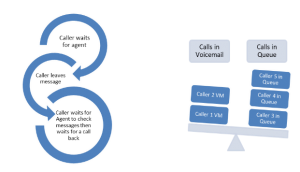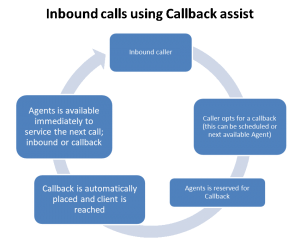Hello, 1980 called, they want their Voicemail back…
In the 70s we started using Voicemail in the work place, it gained momentum and reached popularity in the 80s but by 2012 it was in decline. (Information found on Google!)
While businesses grow and evolve; they find more effective ways to communicate in the moment and on demand. So what is it that keeps us checking voicemail?
If you think about it, there are many more effective ways to leave messages other than voicemail; SMS (text messaging), IM (Instant Messaging), Social Media just to name a few.
If you look back at how Contact Center businesses in 1980 operated, would we consider it effective? Maybe; but there is always room for improvement. For years technology has been on the move changing the status-quo.
When thinking about how to move calls through Contact Centers, we also need to think about how to manage Agent time in relation to those calls.
In the past few years Technology has been able to meet most of our needs for efficiently moving calls and effectively managing Agent time but it may just be that emotion and habit stand in our way from effectively implementing those features that will heighten efficiencies.
An effective feature is automated Call Back. Let’s consider two features for our waiting customers;
The Manual Voicemail option requiring all subsequent interactions to be human and the Call back option that allows for automation and little human interaction, with no distraction from queued calls!
Voicemail VS Call Back
- Is one better than the other?
- Would using automation to keep agents available for customer calls be best Practice?
- Why is Callback so appealing to contact centers?
- What is our priority in bound callers or inbound voicemails?
Let’s take a look at the call flow…..
It is very easy for our agents to get caught up in the cycle of having to ignore inbound calls to access voicemail to return messages left by customers; only to have other customers waiting to be answered. Maybe you have addressed this break in the process by adding a few agents who are responsible for returning voicemail messages, or maybe you have removed the option for your customers all together making it great for your agents but hurting your overall Customer experience.
If we look closer at what is happening its very clear that a drastic change has to be made! We are not actually effectively handling our calls we are effectively moving them around causing frustration for both Agents and Customer.
Inbound Agents
Agents login to queue to receive calls; without callback, they have to;
- Logout of queue leaving their peers to continue to take inbound calls, increasing customer wait times and creating disconnects in reporting.
- Agents then have to login to voicemail and transcribe recorded names and telephone numbers which may have to be repeated a number of times for accuracy.
- Agents then have to logout of voicemail and return the call
- Login to the queue to start receiving inbound calls again.
This is a very manual process leaving lots of room for human error.
Automated Blended Agents
Blending your Contact center for both Inbound and Outbound calls will allow for equalized work flow between all agents.
- Minimize fragmented reporting.
- Lessen frustration levels for customers requiring simplicity with a callback option.
- Decrease the risk associated with leaving the responsibility of transcribing messages.
- Reduce the risk of stacking calls in your contact center due to high percentages of Agents logging off to return messages.
Outbound Agents
Staffing your contact center for outbound only Agents is not only ineffective but extremely expensive, unless outbound calling is all you do. Imagine calls waiting in queue while you have agents trying to reach clients who are unresponsive.
When designing your Contact Center routing, it’s best to keep your customers in mind and what would give them the best possible experience.
Callback
Offering your customers the option for a callback will keep them happy in high traffic times. Maintaining a place in queue, customers can go about their business instead of being tethered to the phone. This will alleviate frustrations for both your customer and your Agent! Taking it one step further and offering scheduled callbacks to customer provides next level CX for your clients.
Voicemail
Removing your voicemail option removes the negative underlying notations that you will respond whenever you get a chance to! The message here is voicemail jail; it’s where calls and customer service go to expire!
Automation
Whenever and wherever possible, it is always best practice to use automation instead of relying on human interactions. Having a system that will distribute calls evenly to those available agents eliminates a lot of manual time consuming processes. Keeping things simple and easy to manage!
Reporting
Always remember that what you do at the top will always have lasting effects down the line. As a contact Center leader, you will need clean data to report on. The time, energy and processes that have to be put in place for Voicemail retrieval will obviously lead to disjointed data streams and inaccurate reports!
Use Callback for;
- customer first focused Contact center
- ensuring your agents are available for calls
- for evenly distributed calls
- seamless blended calling
- accurate metrics



